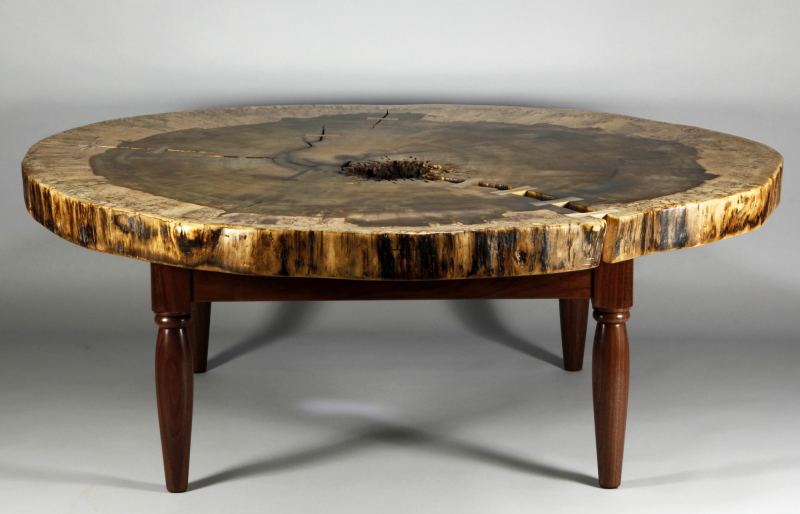Trees from Thomas Jefferson's
Monticello

This section gives the history of the
various trees from Monticello I have been able to work with.
To look at the bowls, please click here, to look at recent tables and benches click here.
I have done various architectural lathe work for Monticello since 1995, beginning with a reproduction of the east privy finial in 1995, a unique Jefferson design sundial in 2001, and a new privy finial in 2003. Bob Self, Conservator of Architecture and Furniture for Monticello, contacted me for this work. He also called me about a copper beech in 2001 and a Carolina silverbell in 2003 that grew next to the house and had to be taken down, and I turned a series of bowls for Monticello out of each of them.
In 2008 the large tulip poplar that stood next to the southwest corner of the house had to be taken down due to root disease. When I read about the upcoming event I called Bob Self to see if I might be able to turn some of it. Several months later I was allowed to come up for one van load from the remainders. I was amazed at the unique character of the 200 year old tree, made particularly special by the hollow sections which yielded a jagged burnt upper edge for the series of bowls from it. In 2009 I worked out an arrangement with Peter Hatch, the Director of Gardens and Grounds , and with the Monticello Museum Shop, to be allowed access to the rest of the tree still stored on the grounds. From then on bowls would be signed "Monticello Tulip Poplar", numbered in sequence, documented by photograph, and a set percentage of all sales would go to the Thomas Jefferson Foundation. This has turned out to be a fine arrangement, as Monticello has a special place of interest for a large number of people, and this provides tangible durable tribute to the remarkable tree that graced the corner of the house for so many decades. Most of the bowls have been sold by the Monticello Museum Shop, but I was allowed to sell to my own customer base. There is more detail on this tree in the link to the left.
Several other turners in the central Virginia area have been involved in this endeavor, including Kirk McCauley, Nate Hawkes, Dick Hines, Elbert Dale, Willie Simmons, Mack Pearce, and Don Voas, all making various bowls, rolling pins, Christmas ornaments, and writing pens for the Museum Shop to sell.
On April 26, 2011 a microburst shot past Monticello leaving a swath of destruction. Two notable trees next to the main building were taken down, fortunately blown away from the house. These were a sugar maple down the path by the south privy, and the European linden with a double trunk that stood right by the front steps. Had the winds been otherwise, the damage would have been devastating to Jefferson's home. I was contacted by Monticello and spent quite a few days getting the best portions of these trees that were suitable for turning.
Later that summer Monticello decided to take the second huge tulip poplar down, due to the possibility of significant damage should it fall during a storm, fearing that the same root disease that devastated the first tulip poplar was taking hold on it too. The tree was only hollow right by the base, allowing some of the sound wood to be sawn up by a Wood Mizer bandsaw mill for future reproduction work, and to saw out an immense blank, weighting close to a ton, for the production of a salt trough to be displayed in the smokehouse at Monticello. The balance of the logs will provide stock for a second series of special bowls from Monticello.
For a short essay on my philosophy on working with this special Monticello wood, with a focus on tables, click here.